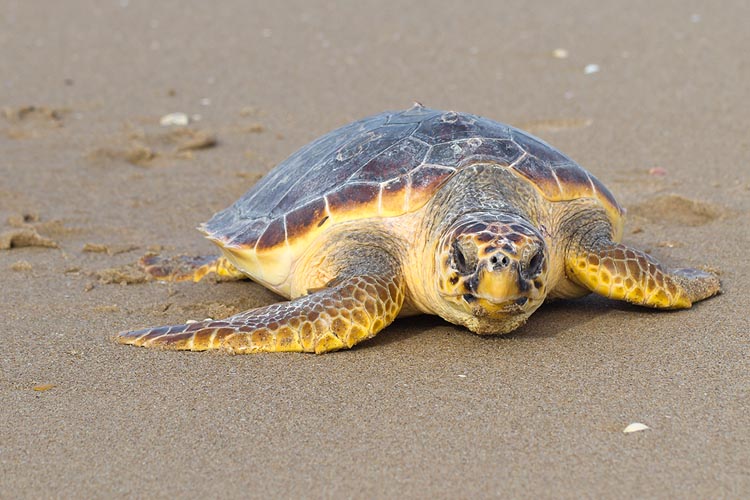
World Turtle Day: highest number of UK turtle sightings recorded for almost a decade, plus an important new Turtle Action Plan announced by the government of Montserrat
Research by Marine Environmental Monitoring (MEM) has found that 47 turtles were spotted in UK and Irish waters during 2022, almost double the number sighted in 2022 and the most seen since 2014, when 52 sightings were reported.
Volunteer citizen scientists from the Marine Conservation Society and other member organisations of the Turtle Implementation Group have helped to compile the 2023 Annual Turtle Report. The most frequently reported species last year in UK and Irish waters was the loggerhead turtle (Caretta caretta), which accounted for 28 of the total sightings.
Reports of hard-shelled turtles found stranded alive on beaches in 2023 were the highest since turtle sighting records began in 1748. The figure coincides with data showing the highest ocean surface temperatures ever recorded during 2023, and an above-average number of storms during the 2023/2024 UK storm season, which may be responsible for the increase in loggerhead turtle sightings over the year.
‘Although we are not 100 per cent confident where these hard-shelled turtles have arrived from, it’s highly likely they are from the North American region,’ said Rod Penrose, Turtle Data Manager at MEM. ‘Unfortunately, storms can drive them into colder waters around the UK and Ireland where they become “cold-stunned” and their bodies shut down. The much larger leatherback turtle is a regular visitor to our waters and has the ability to raise its temperature to cope with our climate.
Related stories
- Marine Conservation Society’s open letter to political leaders
- MCS report finds increase in UK and Irish jellyfish sightings
- MCS recommendations for more sustainable seafood shopping
- MCS ‘State of Our Beaches’ report highlights need to cut plastic pollution
- UK Govt expands sewage plan to England’s protected seas

‘The high numbers of hard-shelled turtles recorded in 2023, mostly loggerheads, may be a result of climate change,’ added Penrose. ‘Many of these displaced turtles become stranded on our beaches and may appear dead but possibly still be alive. Therefore, it is important to report all sightings and strandings as soon as possible to your appropriate contact who can be found in the UK and Irish Turtle Code.’
The leatherback turtle (Dermochelys coriacea) – the sole species capable of adapting to the UK’s cooler waters – migrates to UK and Irish waters to feed on the vast blooms of jellyfish which often occur around the British Isles. The Marine Conservation Society’s 2023 Wildlife Sightings report showed a 32 per cent increase in jellyfish sightings over 2022, together with a 52 per cent increase in blooms of more than 100 individuals.
Despite the influx of large numbers of jellyfish, leatherbacks accounted for just 13 sightings in 2023, although the report suggests that the overall decrease in numbers is due to ‘reduced effort’, by way of comparison with the previous decade.
Of the 47 turtles sighted during 2023, 27 were alive and 14 loggerheads and one Kemp’s ridley turtle (Lepidochelys kempii) were recorded as ‘live-stranded’. Eleven of the stranded turtles – including the Kemp’s ridley – were rehabilitated and made a full recovery.
‘Understanding when and where turtles are sighted in UK waters is crucial for their protection,’ said Hannah Bester, Senior Manager of Volunteering and Citizen Science at the Marine Conservation Society. ‘Our citizen science volunteers play a vital role in identifying trends in jellyfish habitats and marine turtle distribution, which provides valuable insights into the effects of climate change on our ocean.’
Montserrat Turtle Action Plan
In a separate and positive development, the turtle population in the British Overseas Territory of Montserrat has received a significant boost with the formation of a Turtle Action Plan to safeguard their future.
The plan – a UK Government-funded collaboration between the Montserrat government, the Marine Conservation Society and the University of Exeter – involves evidence-based biological research to conserve the Caribbean island’s turtles while simultaneously respecting the values and cultural traditions of the local population.
Turtles are an important part of Montserrat’s marine biodiversity, and the island is one of five Caribbean UK Overseas Territories where the Marine Conservation Society operates.
What to do if you spot a UK/Irish turtle
The most common location to spot marine turtles is the southwest coast of England, but they have, over the years, been seen as far north as Shetland.
Turtle (and jellyfish) sightings from anywhere in the British Isles can be reported on the Marine Conservation Society’s Wildlife Sightings Report page.
The charity’s Turtle Code (also downloadable from the sightings report page) contains an ID guide for the turtles likely to be encountered around the UK and Ireland, and provides advice on what to do if a stranded turtle is found, either at sea or on shore.


